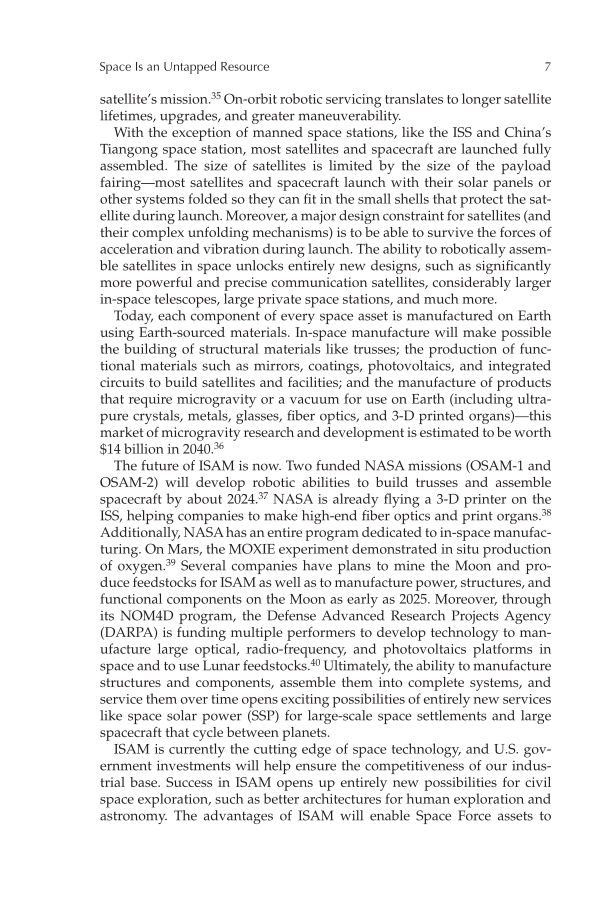Space Is an Untapped Resource 7 satellite’s mission.35 On-orbit robotic servicing translates to longer satellite lifetimes, upgrades, and greater maneuverability. With the exception of manned space stations, like the ISS and China’s Tiangong space station, most satellites and spacecraft are launched fully assembled. The size of satellites is limited by the size of the payload fairing—most satellites and spacecraft launch with their solar panels or other systems folded so they can fit in the small shells that protect the sat- ellite during launch. Moreover, a major design constraint for satellites (and their complex unfolding mechanisms) is to be able to survive the forces of acceleration and vibration during launch. The ability to robotically assem- ble satellites in space unlocks entirely new designs, such as significantly more powerful and precise communication satellites, considerably larger in-space telescopes, large private space stations, and much more. Today, each component of every space asset is manufactured on Earth using Earth-sourced materials. In-space manufacture will make possible the building of structural materials like trusses the production of func- tional materials such as mirrors, coatings, photovoltaics, and integrated circuits to build satellites and facilities and the manufacture of products that require microgravity or a vacuum for use on Earth (including ultra- pure crystals, metals, glasses, fiber optics, and 3-D printed organs)—this market of microgravity research and development is estimated to be worth $14 billion in 2040.36 The future of ISAM is now. Two funded NASA missions (OSAM-1 and OSAM-2) will develop robotic abilities to build trusses and assemble spacecraft by about 2024.37 NASA is already flying a 3-D printer on the ISS, helping companies to make high-end fiber optics and print organs.38 Additionally, NASA has an entire program dedicated to in-space manufac- turing. On Mars, the MOXIE experiment demonstrated in situ production of oxygen.39 Several companies have plans to mine the Moon and pro- duce feedstocks for ISAM as well as to manufacture power, structures, and functional components on the Moon as early as 2025. Moreover, through its NOM4D program, the Defense Advanced Research Projects Agency (DARPA) is funding multiple performers to develop technology to man- ufacture large optical, radio-frequency, and photovoltaics platforms in space and to use Lunar feedstocks.40 Ultimately, the ability to manufacture structures and components, assemble them into complete systems, and service them over time opens exciting possibilities of entirely new services like space solar power (SSP) for large-scale space settlements and large spacecraft that cycle between planets. ISAM is currently the cutting edge of space technology, and U.S. gov- ernment investments will help ensure the competitiveness of our indus- trial base. Success in ISAM opens up entirely new possibilities for civil space exploration, such as better architectures for human exploration and astronomy. The advantages of ISAM will enable Space Force assets to
Document Details My Account Print multiple pages
Print
You have printed 0 times in the last 24 hours.
Your print count will reset on at .
You may print 0 more time(s) before then.
You may print a maximum of 0 pages at a time.


















































































































































































































































